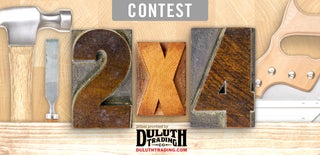Introduction: 2x4 Enchanted Treasure Box
Well now you've done it. It's almost Christmas and you forgot "someone's" gift. Before your hang your head in shame, refuse to accept defeat. Take a walk to the garage. Can you find:
-a 2x4
-an inch of 1/4" dowel
-a square bit of 1/4" plywood
...Seriously, $3 worth of leftovers and a little determination can snatch victory from the jaws of defeat but therein lies the trick: This, at all costs, cannot resemble a stained-up and screw-riddled 2x4 that you've been using to prop up a shelf. Since 2x4 pine doesn't have much in the way of color or grain, we'll have to fake our way to both.
For this project, you'll need a tablesaw and joiner to prep the lumber. More importantly, you'll need a carving wheel and a 4.5" angle grinder. I used the Galahad from King Arthur's Tools alongside various rotary tool carving and sanding bits.
** One note about safety: Remember, we are going to be turning about half the mass of a 2x4 beam into powder. You don't want to be breathing all of that and/or tracking it through your house. This is a great project to be attempted by the open garage door with the vacuum running while wearing an apron, respirator, gloves and goggles. Any dust you can avoid ingesting is a good step so use your best judgment.
Let's get started building our enchanted treasure box!
Step 1: Making the Box
You've built some sort of a mitered box before, right? Well this isn't going to be too much different. Select your finest 2x4 or drag the rattiest one you've got back in from the porch. Cut four pieces with mitered corners to build the sides of the box.
Use a joiner to smooth off the top of each piece, then move to the tablesaw and rip them to the same height by taking a tiny bit from the bottom.
Next, plan the notches on the inside. You'll need 3. One will be the recess for the lid. The second will capture the plywood bottom and the last will be an offset to make the legs appear less chunky. Trim away the excess until you get the look you want.
Finally, you'll need a slot for the handle (Which you'll add to the lid later). Use a crosscut sled or miter gauge to cut the slot away.
Dry-fit all parts and cut your plywood to fit in the slot.
Use a sander or hand plane to clean up the inside and the areas that you hit with the tablesaw. Don't worry about the outside. We'll be doing plenty of carving at that later on.
Add biscuits, dominoes or dowels to the mitered corners for reinforcement. I placed mine as close as possible to the interior so that I wouldn't risk carving into them from the outside.
Step 2: The Lid
Like the sides, we'll use some more 2x4. Resaw a board, joint the ends and glue the edges of the board up. After drying, plane and sand it smooth and fit it to the box.
Add four small felt pads on the inside for the lid to sit upon and use a drill to bore the holes for the dowel hinges. I used 1/4" dowels, so I also enlarged the inner holes (the part on the lid) to 1/64 over, allowing it to rotate easily (the bit is 17/64"). If you don't have the bit, simply rock the drill back and forth a little to ream the sides.
Use half-inserted dowels to keep the parts together but don't insert them all the way, as you'll want to be able to separate the parts later. Keep at least 1/2" exposed and use Vice Grip pliers to remove them if needed.
Step 3: Carving Pt 1...
Since we need to change the shape of the 2x4, routing the edge simply won't do. I found a number of examples of similar boxes made from exotic lumber but as this is pine, we can call it practice.
I started with marking a spiral from the middle of the lid with lines that swept out around and over the edges, ending near the base. I wanted the ridges to not start or stop anywhere on the surface so they'll need to branch and merge as they travel around.
Use a bright pen to mark the tops of the ridges. You'll use the grinder to remove material from each side but keep the lines intact.
Remember, this is a 2x4. It's THICK so don't be afraid to carve it deep and really bring out the three-dimensional look of the shape.
Step 4: Carving Part 2...
The downside of the Galahad is that it's big and leaves some serious scratches. Give it a break; it's built to carve everything up to landscaping stone. To fix this, switch to a flap sander on the grinder and start removing some of the major cuts.
If you want to add more intricate turns, you'll have to switch to a Dremel or other rotary tool. Keep the theme with the rounded features and make them wrap around the box. As you get to the end, gently round over the ridges themselves and remove any remaining 2x4 surface along with the pen marks.
Step 5: Sanding
So now you should have a rough sculpted box. To get rid of the major scratches, I used a flap sander on the angle grinder. For the tighter corners and more intricate details I used my Dremel with a variety of sanding drums.
As this was my first attempt, I realized too late that there would be no way to remove every trace of the Dremel scars and give the box the flowing look I originally envisioned. Had I done it again, I think I would have made a design that could be completed 100% without the smaller rotary tools. Maybe in the next revision...
Step 6: Dyeing, Staining, Painting and Varnishing
Since pine doesn't have much in the way of grain, it'll take a few layers to give it some color.
Start with aniline dye mixed with denatured alcohol and brush a thin coat over the entire project. Be very careful to not slop multiple layers, as that will build up the color.
After it dries, use a random orbit sander with 300-400 grit paper to sand halfway through the dyed layer. This will add depth to the finish and will make the tops of the ridges a little pale.
On top of the dye, brush on a coat of dark walnut or kona/Jacobean stain. Again, let it dry and sand a bit through the highlights. Repeat with other colors until you reach the mix you're looking for.
After the staining, I used a very light coat of paint to further extenuate the tops of the ridges.
Once everything is dry, I used a urethane topcoat to apply a thick, super-high-gloss finish over the entire project.
Step 7: The Very End!
Once all the finish is dry, add felt feet to the base and to the underside of the lid. You can also cut a felt sheet to cover the bottom of the box. If you've got time and/or effort to spare, you can also add dividers to the interior.
As it stands, your 2x4 box could look at home in your workshop or in any necromancer's abode.
The end! If you made it, Congratulations! You've saved the day and have something to bring out on Christmas morning! No one needs to know it started life as a 2x4 that you had previously used to prop up your workbench. ;)

Runner Up in the
Leftovers Challenge

Runner Up in the
2x4 Contest

Participated in the
Homemade Gifts Contest 2015













